Investigating the Recent Surge in the Monomah Glacier, Central Kunlun Mountain Range with Multiple Sources of Remote Sensing Data
Abstract
1. Introduction
2. Study area and datasets
2.1. Study Area
2.2. Datasets
2.2.1. Synthetic Aperture Radar Images
2.2.2. Optical Images
2.2.3. Digital Elevation Model
3. Methods
3.1. DEM Generation
3.2. Estimation of Changes in Glacier Surface Height
3.3. Estimation of Glacier Flow Velocity
3.4. Delineation of Glacier Boundary and Identification of Changes in Glacier Morphology
4. Results
4.1. Changes of Thickness in the Monomah Glacier
4.2. Changes of Flow Velocity in the Monomah Glacier
4.3. Changes of Boundaries and Morphology in the Monomah Glacier.
5. Discussion
5.1. Uncertainty Analysis
5.2. The Surge Process of the Monomah Glacier
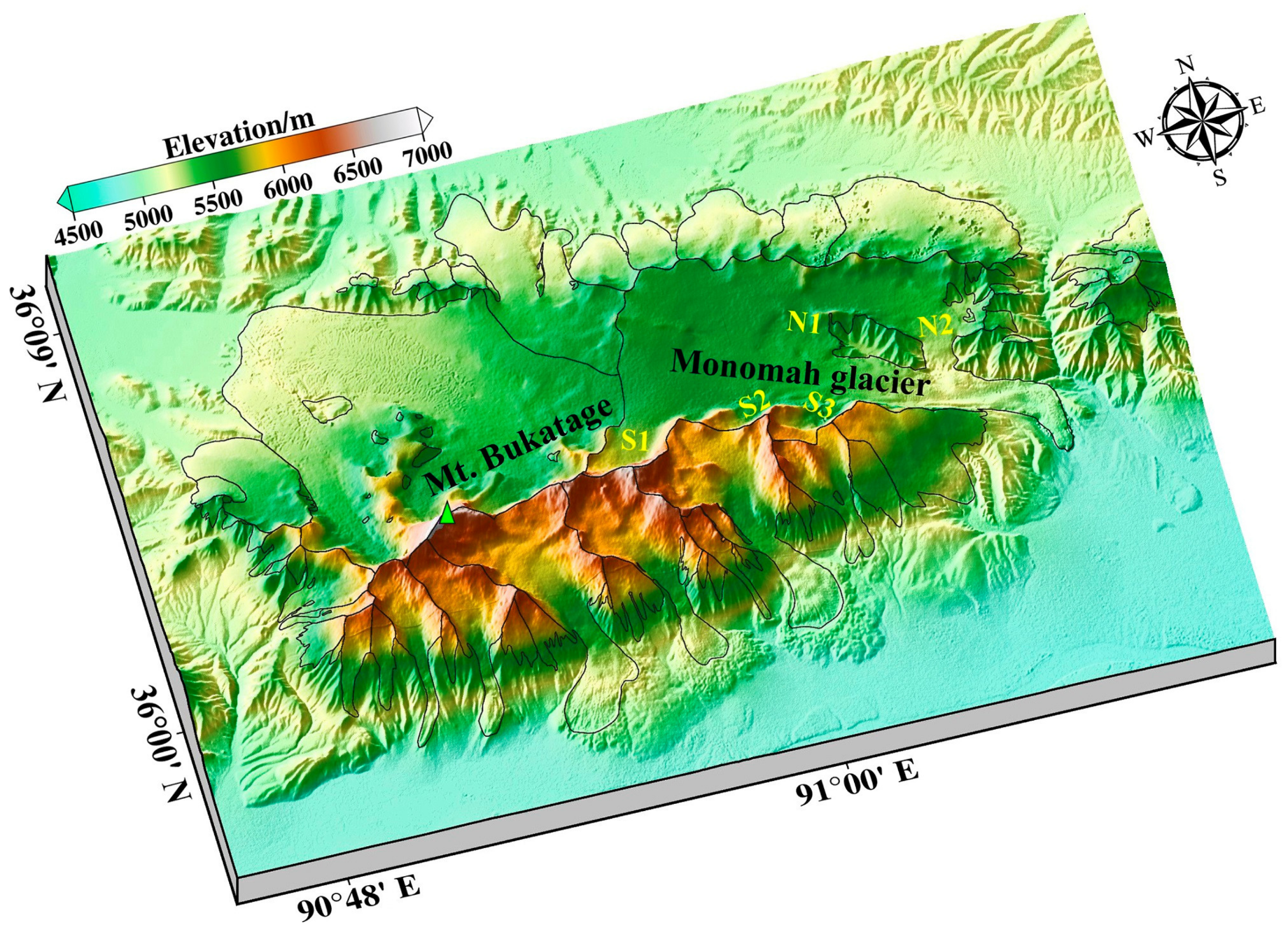
5.3. Surge Mechanism of the Monomah Glacier
6. Conclusions
Author Contributions
Funding
Acknowledgments
Conflicts of Interest
References
- Xie, Z.; Liu, C. Introduction of Glaciology, 1st ed.; Shanghai Popular Science Press: Shanghai, China, 2010; (In Chinese). ISBN 978-7-54-274449-4. [Google Scholar]
- Cuffey, K.; Paterson, W.S.B. The Physics of Glaciers, 4th ed.; Butterworth-Heinemann/Elsevier: Burlington MA, USA, 2010; ISBN 0123694612. [Google Scholar]
- Jiskoot, H. Glacier Surging. In Encyclopedia of Snow, Ice and Glaciers; Singh, V.P., Singh, P., Haritashya, U.K., Eds.; Springer: Dordrecht, The Netherlands, 2011; pp. 415–428. ISBN 978-9-04-812641-5. [Google Scholar]
- Bhambri, R.; Hewitt, K.; Kawishwar, P.; Pratap, B. Surge-type and surge-modified glaciers in the Karakoram. Sci. Rep. 2017, 7, 15391. [Google Scholar] [CrossRef] [PubMed]
- Kamb, B. Glacier surge mechanism based on linked cavity configuration of the basal water conduit system. J. Geophys. Res. 1987, 92, 9083–9100. [Google Scholar] [CrossRef]
- Lingle, C.S.; Fatland, D.R. Does englacial water storage drive temperate glacier surges? Ann. Glaciol. 2003, 36, 14–20. [Google Scholar] [CrossRef]
- Murray, T.; Stuart, G.W.; Miller, P.J.; Woodward, J.; Smith, A.M.; Porter, P.R.; Jiskoot, H. Glacier surge propagation by thermal evolution at the bed. J. Geophys. Res. 2000, 105, 13491–13507. [Google Scholar] [CrossRef]
- Murray, T.; Strozzi, T.; Luckman, A.; Jiskoot, H.; Christakos, P. Is there a single surge mechanism? Contrasts in dynamics between glacier surges in Svalbard and other regions. J. Geophys. Res. 2003, 108, 961. [Google Scholar] [CrossRef]
- Copland, L.; Sylvestre, T.; Bishop, M.P.; Shroder, J.F.; Seong, Y.B.; Owen, L.A.; Bush, A.; Kamp, U. Expanded and Recently Increased Glacier Surging in the Karakoram. Arct. Antarct. Alp. Res. 2011, 43, 503–516. [Google Scholar] [CrossRef]
- Hewitt, K. Glaciers of the Karakoram Himalaya; Springer: Dordrecht, The Netherlands, 2014; ISBN 978-9-40-076310-4. [Google Scholar]
- Kamb, B.; Raymond, C.F.; Harrison, W.D.; Engelhardt, H.; Echelmeyer, K.A.; Humphrey, N.; Brugman, M.M.; Pfeffer, T. Glacier surge mechanism: 1982-1983 surge of variegated glacier, alaska. Science 1985, 227, 469–479. [Google Scholar] [CrossRef]
- Fowler, A.C.; Murray, T.; Ng, F.S.L. Thermally controlled glacier surging. J. Glaciol. 2001, 47, 527–538. [Google Scholar] [CrossRef]
- Quincey, D.J.; Glasser, N.F.; Cook, S.J.; Luckman, A. Heterogeneity in Karakoram glacier surges. J. Geophys. Res. Earth Surf. 2015, 120, 1288–1300. [Google Scholar] [CrossRef]
- Kääb, A.; Berthier, E.; Nuth, C.; Gardelle, J.; Arnaud, Y. Contrasting patterns of early twenty-first-century glacier mass change in the Himalayas. Nature 2012, 488, 495–498. [Google Scholar] [CrossRef]
- Zhou, Y.; Li, Z.; Li, J. Slight glacier mass loss in the Karakoram region during the 1970s to 2000 revealed by KH-9 images and SRTM DEM. J. Glaciol. 2017, 63, 331–342. [Google Scholar] [CrossRef]
- Gardelle, J.; Berthier, E.; Arnaud, Y.; Kääb, A. Region-wide glacier mass balances over the Pamir-Karakoram-Himalaya during 1999–2011. Cryosphere Discuss. 2013, 7, 975–1028. [Google Scholar] [CrossRef]
- Yasuda, T.; Furuya, M. Dynamics of surge-type glaciers in West Kunlun Shan, Northwestern Tibet. J. Geophys. Res. Earth Surf. 2015, 120, 2393–2405. [Google Scholar] [CrossRef]
- Li, Z.; Sun, W.; Zeng, Q. Deriving Glacier Change Information on the Xizang (Tibetan) Plateau by Integrating RS and GIS Techniques. Acta Geographica Sinica 1999, 54, 263–268. (In Chinese) [Google Scholar] [CrossRef]
- Jiang, S.; Yang, T.; Wang, X.; Tian, H. Response of glacier variation to climate change in the Bukatage Ice Cap from 1973 to 2010. J. Arid Land Resour. Environ. 2013, 27, 47–52. (In Chinese) [Google Scholar] [CrossRef]
- Hu, F.; Yang, T.; Ji, Q.; Li, H.; Wang, J. Response of glacier in the Bukatage Mountains to climate change from 1990 to 2015. Arid Land Geography 2018, 41, 66–73. (In Chinese) [Google Scholar] [CrossRef]
- Gao, Y.; Yao, X.; Liu, S.; Qi, M.; Duan, H.; Liu, J.; Zhang, D. Remote sensing monitoring of advancing glaciers in the Bukatage Mountains from 1973 to 2018. J. Nat. Resour. 2019, 34, 1666–1681. (In Chinese) [Google Scholar] [CrossRef]
- Zhou, Y.; Hu, J.; Li, Z.; Li, J.; Zhao, R.; Ding, X. Quantifying glacier mass change and its contribution to lake growths in central Kunlun during 2000–2015 from multi-source remote sensing data. J. Hydrol. 2019, 570, 38–50. [Google Scholar] [CrossRef]
- Meier, M.F.; Post, A.S. What are glacier surges? Can. J. Earth Sci. 1969, 6, 807–817. [Google Scholar] [CrossRef]
- Paul, F. Revealing glacier flow and surge dynamics from animated satellite image sequences: Examples from the Karakoram. Cryosphere 2015, 9, 2201–2214. [Google Scholar] [CrossRef]
- Guo, W.; Liu, S.; Xu, J.; Wu, L.; Shangguan, D.; Yao, X.; Wei, J.; Bao, W.; Yu, P.; Liu, Q.; et al. The second Chinese glacier inventory: Data, methods and results. J. Glaciol. 2015, 61, 357–372. [Google Scholar] [CrossRef]
- Strozzi, T.; Luckman, A.; Murray, T.; Wegmüller, U.; Werner, C. Glacier motion estimation using SAR offset-tracking procedures. IEEE Trans. Geosci. Remote Sens. 2002, 40, 2384–2391. [Google Scholar] [CrossRef]
- Ye, Q.; Bolch, T.; Naruse, R.; Wang, Y.; Zong, J.; Wang, Z.; Zhao, R.; Yang, D.; Kang, S. Glacier mass changes in Rongbuk catchment on Mt. Qomolangma from 1974 to 2006 based on topographic maps and ALOS PRISM data. J. Hydrol. 2015, 530, 273–280. [Google Scholar] [CrossRef]
- Li, Z.; Li, J.; Ding, X.; Wu, L.; Ke, L.; Hu, J.; Xu, B.; Peng, F. Anomalous Glacier Changes in the Southeast of Tuomuer-Khan Tengri Mountain Ranges, Central Tianshan. J. Geophys. Res. Atmos. 2018, 123, 6840–6863. [Google Scholar] [CrossRef]
- Tadono, T.; Ishida, H.; Oda, F.; Naito, S.; Minakawa, K.; Iwamoto, H. Precise Global DEM Generation by ALOS PRISM. ISPRS Ann. Photogramm. Remote Sens. Spatial Inf. Sci. 2014, 2, 71–76. [Google Scholar] [CrossRef]
- Rodríguez, E.; Morris, C.S.; Belz, J.E. A Global Assessment of the SRTM Performance. Photogramm Eng Remote Sens. 2006, 72, 249–260. [Google Scholar] [CrossRef]
- Pieczonka, T.; Bolch, T.; Junfeng, W.; Shiyin, L. Heterogeneous mass loss of glaciers in the Aksu-Tarim Catchment (Central Tien Shan) revealed by 1976 KH-9 Hexagon and 2009 SPOT-5 stereo imagery. Remote Sens. Environ. 2013, 130, 233–244. [Google Scholar] [CrossRef]
- Holzer, N.; Vijay, S.; Yao, T.; Xu, B.; Buchroithner, M.; Bolch, T. Four decades of glacier variations at Muztagh Ata (eastern Pamir): A multi-sensor study including Hexagon KH-9 and Pléiades data. Cryosphere 2015, 9, 2071–2088. [Google Scholar] [CrossRef]
- Nuth, C.; Kääb, A. Co-registration and bias corrections of satellite elevation data sets for quantifying glacier thickness change. Cryosphere 2011, 5, 271–290. [Google Scholar] [CrossRef]
- Li, J.; Li, Z.; Zhu, J.; Li, X.; Xu, B.; Wang, Q.; Huang, C.; Hu, J. Early 21st century glacier thickness changes in the Central Tien Shan. Remote Sens. Environ. 2017, 192, 12–29. [Google Scholar] [CrossRef]
- Luckman, A.; Quincey, D.J.; Bevan, S. The potential of satellite radar interferometry and feature tracking for monitoring flow rates of Himalayan glaciers. Remote Sens. Environ. 2007, 111, 172–181. [Google Scholar] [CrossRef]
- Sansosti, E.; Berardino, P.; Manunta, M.; Serafino, F.; Fornaro, G. Geometrical SAR image registration. IEEE Trans. Geosci. Remote Sens. 2006, 44, 2861–2870. [Google Scholar] [CrossRef]
- Li, J.; Li, Z.; Ding, X.; Wang, Q.; Zhu, J.; Wang, C. Investigating mountain glacier motion with the method of SAR intensity-tracking: Removal of topographic effects and analysis of the dynamic patterns. Earth-Sci. Rev. 2014, 138, 179–195. [Google Scholar] [CrossRef]
- Buades, A.; Coll, B.; Morel, J.-M. A Non-Local Algorithm for Image Denoising. In Proceedings of the 2005 IEEE Computer Society Conference on Computer Vision and Pattern Recognition (CVPR’05), San Diego, CA, USA, 20–26 June 2005; IEEE: New York, NY, USA, 2005; pp. 60–65, ISBN 0-7695-2372-2. [Google Scholar]
- Paul, F.; Bolch, T.; Briggs, K.; Kääb, A.; McMillan, M.; McNabb, R.; Nagler, T.; Nuth, C.; Rastner, P.; Strozzi, T.; et al. Error sources and guidelines for quality assessment of glacier area, elevation change, and velocity products derived from satellite data in the Glaciers_cci project. Remote Sens. Environ. 2017, 203, 256–275. [Google Scholar] [CrossRef]
- Höhle, J.; Höhle, M. Accuracy assessment of digital elevation models by means of robust statistical methods. ISPRS J. Photogramm. Remote Sens. 2009, 64, 398–406. [Google Scholar] [CrossRef]
- Lambercht, A.; Mayer, C.; Wendt, A.; Floricioiu, D.; Volksen, C. Elevation change of Fedchenko Glacier, Pamir Mountains, from GNSS field measurements and TanDEM-X elevation models, with a focus on the upper glacier. J. Glaciol. 2018, 64, 637–648. [Google Scholar] [CrossRef]
- Werner, C.; Wegmuller, U.; Strozzi, T.; Wiesmann, A. Precision estimation of local offsets between pairs of SAR SLCs and detected SAR images. In Proceedings of the 2005 IEEE International Geoscience and Remote Sensing Symposium, IGARSS ‘05, Seoul, Korea, 25–29 July 2005; IEEE: New York, NY, USA, 2005; pp. 4803–4805, ISBN 0-7803-9050-4. [Google Scholar]
- Fujita, K.; Sakai, A.; Nuimura, T.; Yamaguchi, S.; Sharma, R.R. Recent changes in Imja Glacial Lake and its damming moraine in the Nepal Himalaya revealed by in situ surveys and multi-temporal ASTER imagery. J. Glaciol. 2009, 4, 45205. [Google Scholar] [CrossRef]
- Bolch, T.; Pieczonka, T.; Mukherjee, K.; Shea, J. Brief communication: Glaciers in the Hunza catchment (Karakoram) have been nearly in balance since the 1970s. Cryosphere 2017, 11, 531–539. [Google Scholar] [CrossRef]
- Sole, A.J.; Mair, D.W.F.; Nienow, P.W.; Bartholomew, I.D.; King, M.A.; Burke, M.J.; Joughin, I. Seasonal speedup of a Greenland marine-terminating outlet glacier forced by surface melt–induced changes in subglacial hydrology. J. Geophys. Res. 2011, 116, F01005. [Google Scholar] [CrossRef]
- Dunse, T.; Schuler, T.V.; Hagen, J.O.; Reijmer, C.H. Seasonal speed-up of two outlet glaciers of Austfonna, Svalbard, inferred from continuous GPS measurements. Cryosphere 2012, 6, 453–466. [Google Scholar] [CrossRef]
- Dowdeswell, J.A.; Benham, T.J. A surge of Perseibreen, Svalbard, examined using aerial photography and ASTER high resolution satellite imagery. Polar Res. 2003, 22, 373–383. [Google Scholar] [CrossRef]
- Li, J.; Li, Z.-w.; Wu, L.-x.; Xu, B.; Hu, J.; Zhou, Y.-s.; Miao, Z.-l. Deriving a time series of 3D glacier motion to investigate interactions of a large mountain glacial system with its glacial lake: Use of Synthetic Aperture Radar Pixel Offset-Small Baseline Subset technique. J. Hydrol. 2018, 559, 596–608. [Google Scholar] [CrossRef]
- Quincey, D.J.; Braun, M.; Glasser, N.F.; Bishop, M.P.; Hewitt, K.; Luckman, A. Karakoram glacier surge dynamics. Geophys. Res. Lett. 2011, 38, 1–6. [Google Scholar] [CrossRef]
- Clarke, G.K.C.; Collins, S.G.; Thompson, D.E. Flow, thermal structure, and subglacial conditions of a surge-type glacier. Can. J. Earth Sci. 1984, 21, 232–240. [Google Scholar] [CrossRef]
- Sund, M.; Eiken, T.; Hagen, J.O.; Kääb, A. Svalbard surge dynamics derived from geometric changes. Ann. Glaciol. 2009, 50, 50–60. [Google Scholar] [CrossRef]
- Sevestre, H.; Benn, D.I.; Hulton, N.R.J.; Bælum, K. Thermal structure of Svalbard glaciers and implications for thermal switch models of glacier surging. J. Geophys. Res. Earth Surf. 2015, 120, 2220–2236. [Google Scholar] [CrossRef]
- Jiskoot, H.; Murray, T.; Boyle, P. Controls on the distribution of surge-type glaciers in Svalbard. J. Glaciol. 2000, 46, 412–422. [Google Scholar] [CrossRef]
- Lønne, I. A new concept for glacial geological investigations of surges, based on High-Arctic examples (Svalbard). Quat. Sci. Rev. 2016, 132, 74–100. [Google Scholar] [CrossRef]
- Farnsworth, W.R.; Ingólfsson, Ó.; Retelle, M.; Schomacker, A. Over 400 previously undocumented Svalbard surge-type glaciers identified. Geomorphology 2016, 264, 52–60. [Google Scholar] [CrossRef]
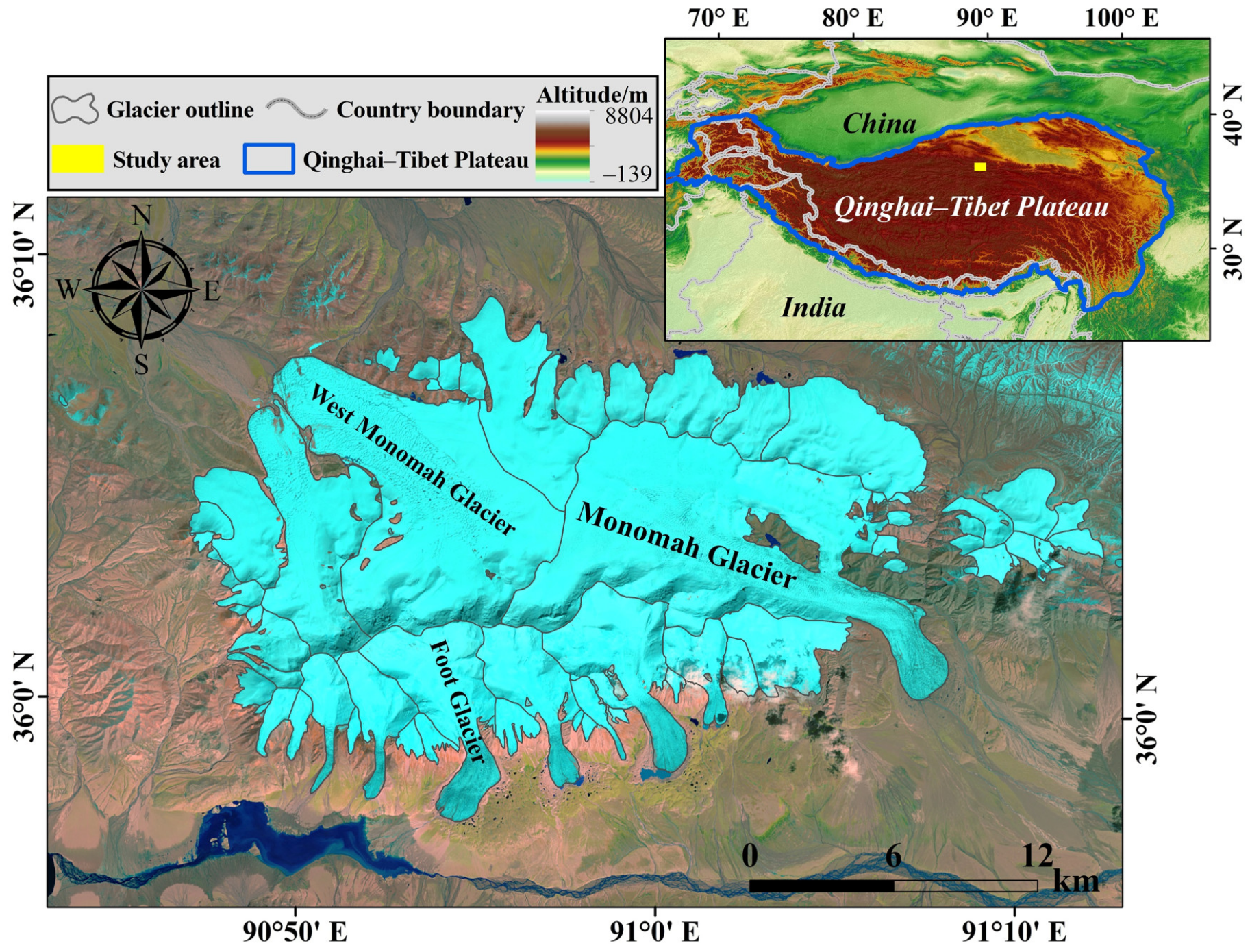

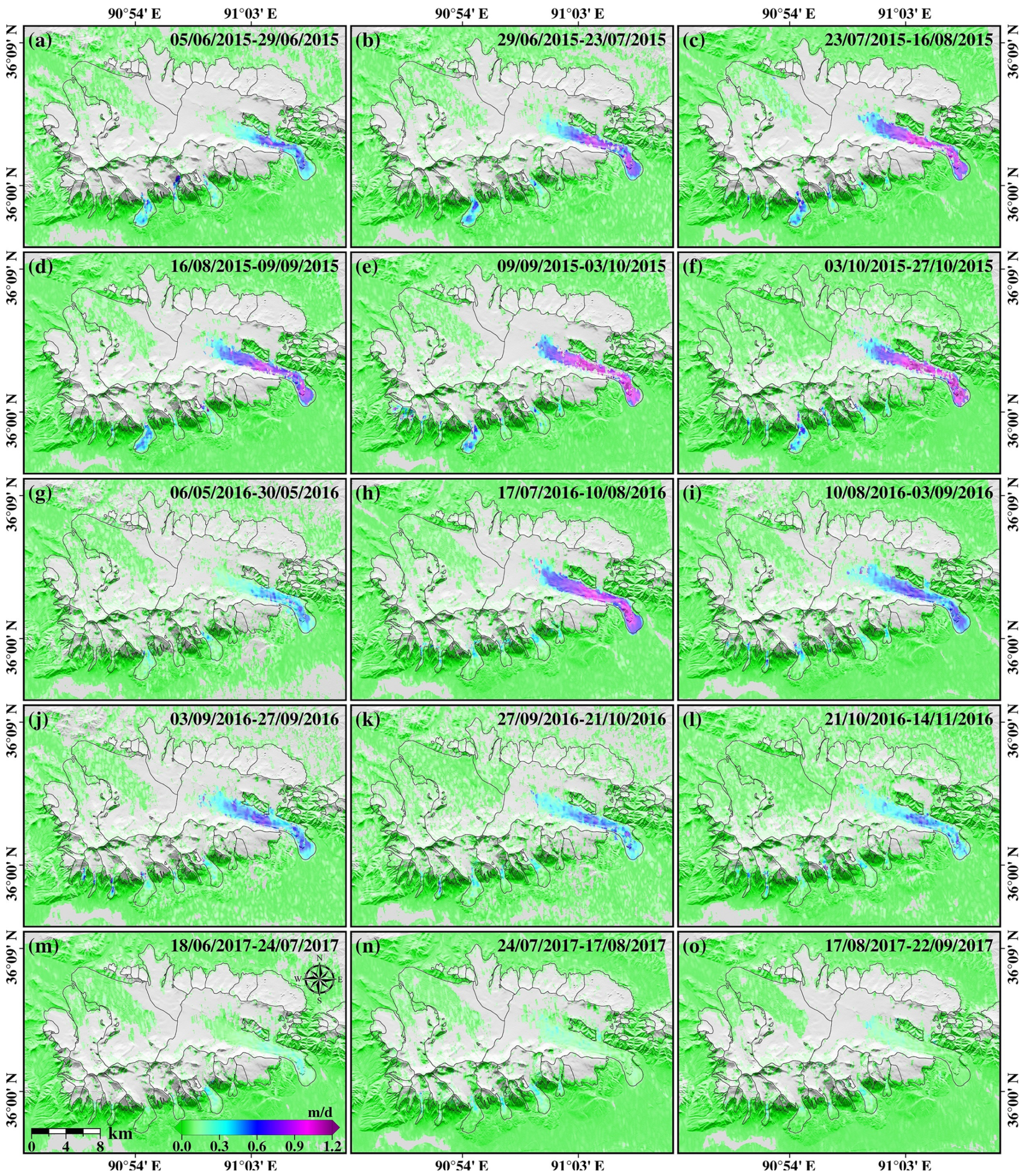
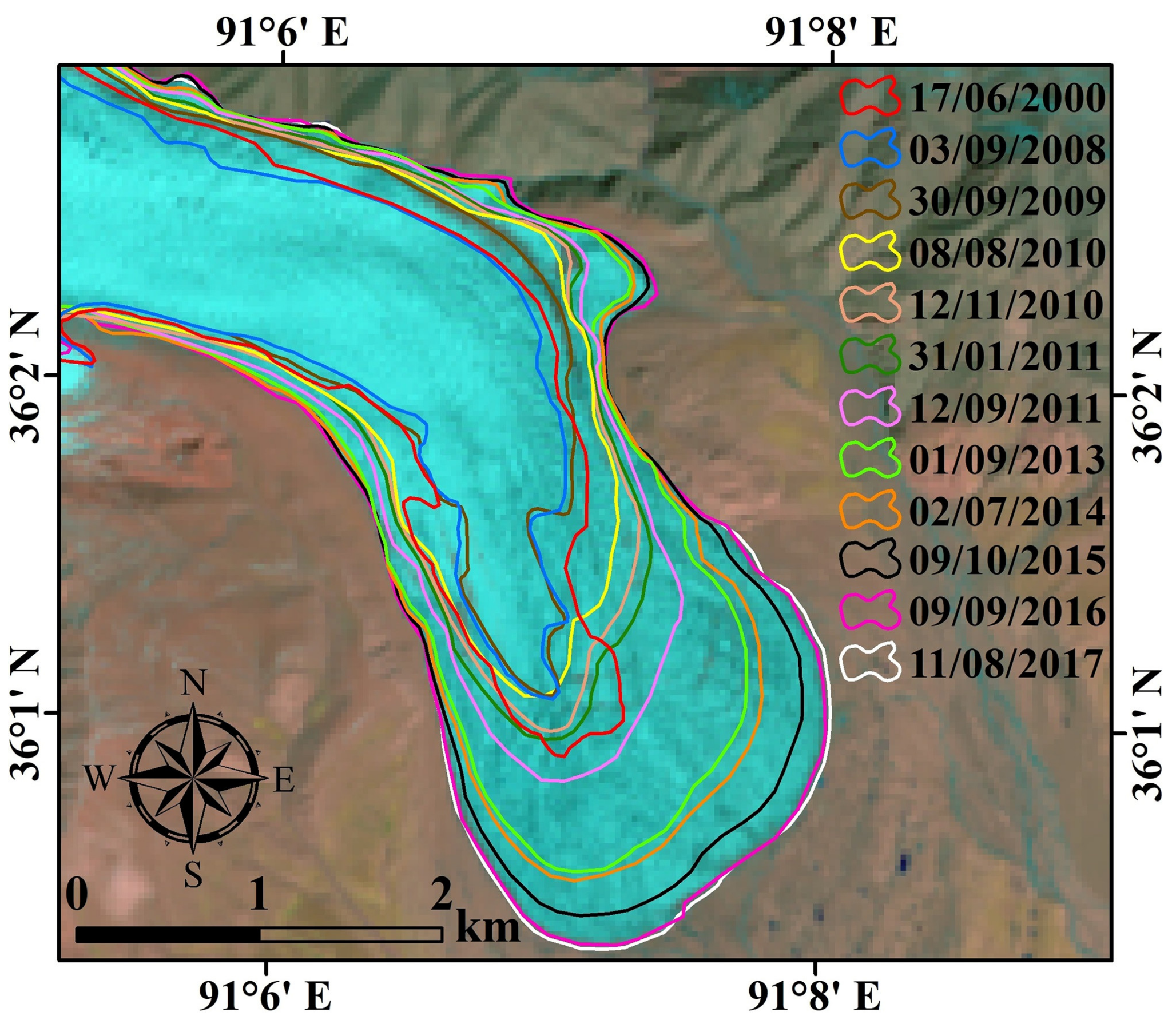
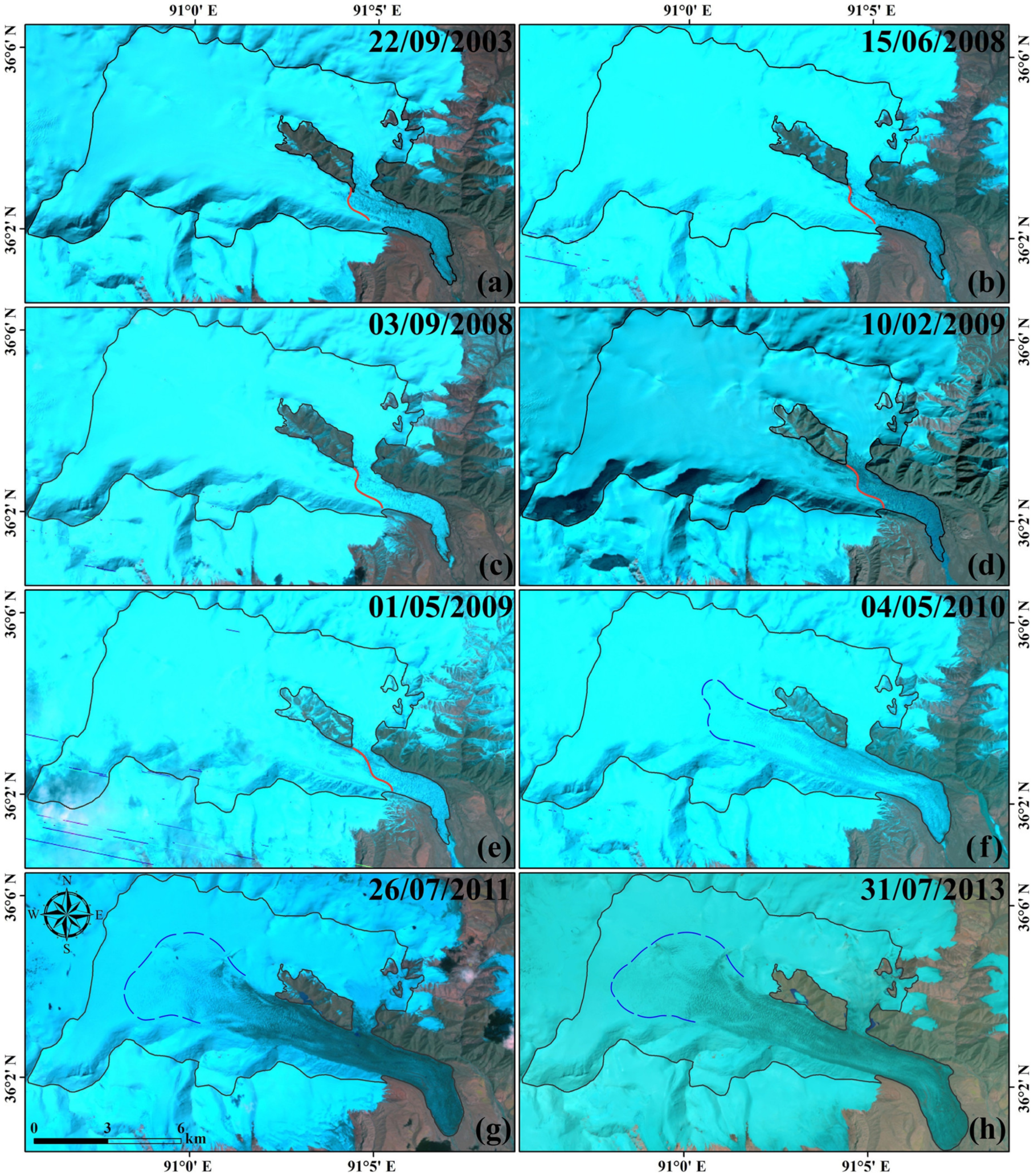
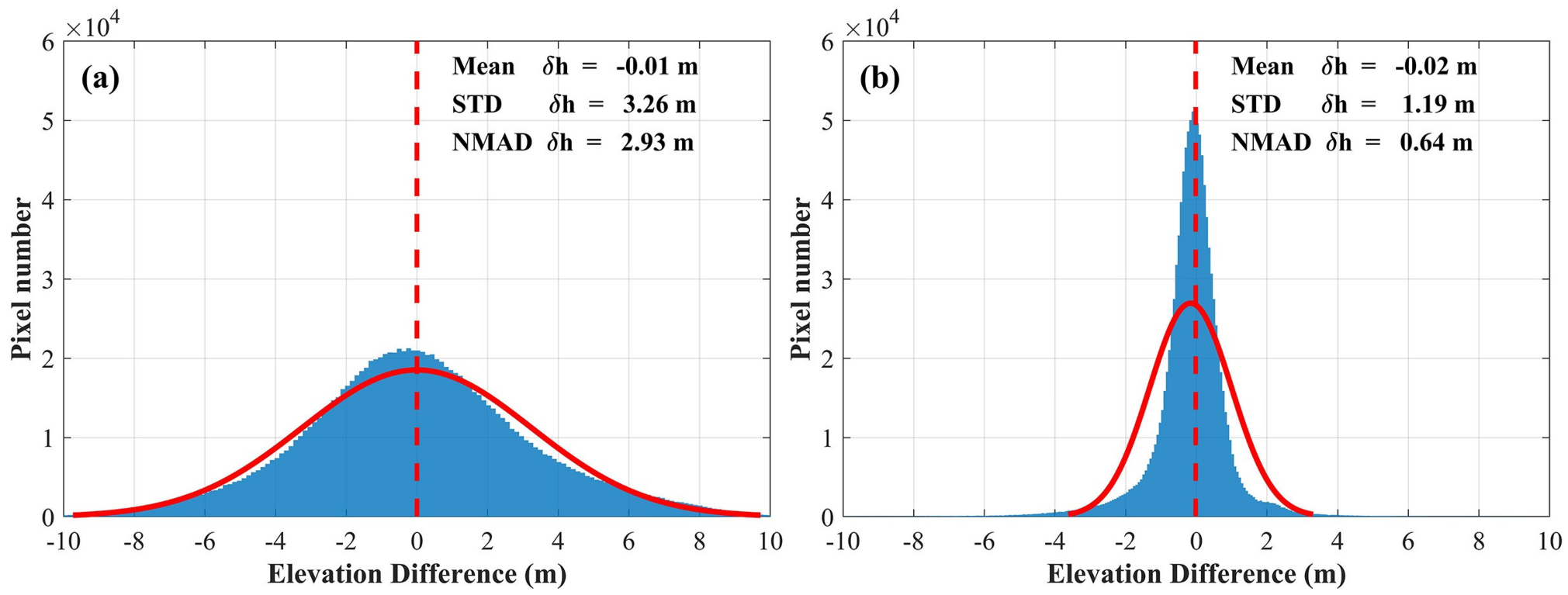
| Datasets | Date | Resolution | Product ID | Usage |
|---|---|---|---|---|
| TanDEM-X | 08 March 2011 | 1.8 m × 2.1 m | dims_op_pl_dfd_XXXXB00000000279029621469 | New DEM generation |
| 08 March 2011 | dims_op_pl_dfd_XXXXB00000000279029621469 | |||
| 05 March 2012 | dims_op_pl_dfd_XXXXB00000000292947470931 | |||
| 05 March 2012 | dims_op_pl_dfd_XXXXB00000000292947470882 | |||
| ALOS/PRISM | 20 November 2009 | 2.5 m × 2.1 m | ALPSMB203652930(Backward) | |
| ALPSMF203652820(Forward) | ||||
| ALPSMN203652875(Nadir) | ||||
| 20 February 2010 | ALPSMB217072930(Backward) | |||
| ALPSMF217072820(Forward) | ||||
| ALPSMN217072875(Nadir) | ||||
| Sentinel-1A | 05 June 2015 | 4 m × 14 m | S1A_IWSV_0114_0119_006238_041 | Flow velocity measurement |
| 29 June 2015 | S1A_IWSV_0115_0120_006588_041 | |||
| 23 July 2015 | S1A_IWSV_0114_0119_006938_041 | |||
| 16 August 2015 | S1A_IWSV_0115_0120_007288_041 | |||
| 09 September 2015 | S1A_IWSV_0115_0120_007638_041 | |||
| 03 October 2015 | S1A_IWSV_0115_0120_007988_041 | |||
| 27 October 2015 | S1A_IWDV_0114_0119_008338_041 | |||
| 06 May 2016 | S1A_IWSV_0114_0119_011138_041 | |||
| 30 May 2016 | S1A_IWSV_0115_0120_011488_041 | |||
| 17 July 2016 | S1A_IWSV_0114_0119_012188_041 | |||
| 10 August 2016 | S1A_IWSV_0114_0119_012538_041 | |||
| 03 September 2016 | S1A_IWSV_0116_0121_012888_041 | |||
| 27 September 2016 | S1A_IWSV_0116_0121_013238_041 | |||
| 21 October 2016 | S1A_IWSV_0114_0119_013588_041 | |||
| 14 November 2016 | S1A_IWSV_0114_0119_013938_041 | |||
| 18 June 2017 | S1A_IWDV_0115_0120_017088_041 | |||
| 24 July 2017 | S1A_IWDV_0115_0120_017613_041 | |||
| 17 August 2017 | S1A_IWDV_0115_0120_017963_041 | |||
| 22 September 2017 | S1A_IWDV_0115_0120_018488_041 | |||
| Landsat/TM | 22 September 2003 | 30 m × 30 m | LT51390352003265BJC00 | Glacier surface change interpretation |
| 15 June 2008 | LT51390352008167BJC01 | |||
| 03 September 2008 | LT51390352008247BJC00 | |||
| 10 February 2009 | LT51390352009041BJC00 | |||
| 01 May 2009 | LT51390352009121BJC01 | |||
| 04 May 2010 | LT51390352010124KHC00 | |||
| 08 August 2010 | LT51390352010220IKR01 | |||
| 12 November 2010 | LT51390352010316IKR01 | |||
| 31 January 2011 | LT51390352011031KHC00 | |||
| 26 July 2011 | LT51390352011207IKR01 | |||
| 12 September 2011 | LT51390352011255IKR01 | |||
| Landsat/ETM+ | 17 June 2000 | 15 m × 15 m | LE71390352000169SGS00 | |
| 30 September 2009 | LE71390352009273SGS00 | |||
| Landsat/OLI | 31 July 2013 | 15 m × 15 m | LC81390352013212LGN00 | |
| 01 September 2013 | LC81390352013244LGN01 | |||
| 02 July 2014 | LC81390352014183LGN00 | |||
| 09 October 2015 | LC81390352015282LGN01 | |||
| 09 September 2016 | LC81390352016253LGN01 | |||
| 11 August 2017 | LC81390352017223LGN00 |
© 2020 by the authors. Licensee MDPI, Basel, Switzerland. This article is an open access article distributed under the terms and conditions of the Creative Commons Attribution (CC BY) license (http://creativecommons.org/licenses/by/4.0/).
Share and Cite
Guo, L.; Li, J.; Wu, L.; Li, Z.; Liu, Y.; Li, X.; Miao, Z.; Wang, W. Investigating the Recent Surge in the Monomah Glacier, Central Kunlun Mountain Range with Multiple Sources of Remote Sensing Data. Remote Sens. 2020, 12, 966. https://doi.org/10.3390/rs12060966
Guo L, Li J, Wu L, Li Z, Liu Y, Li X, Miao Z, Wang W. Investigating the Recent Surge in the Monomah Glacier, Central Kunlun Mountain Range with Multiple Sources of Remote Sensing Data. Remote Sensing. 2020; 12(6):966. https://doi.org/10.3390/rs12060966
Chicago/Turabian StyleGuo, Lei, Jia Li, Lixin Wu, Zhiwei Li, Yanyang Liu, Xin Li, Zelang Miao, and Wei Wang. 2020. "Investigating the Recent Surge in the Monomah Glacier, Central Kunlun Mountain Range with Multiple Sources of Remote Sensing Data" Remote Sensing 12, no. 6: 966. https://doi.org/10.3390/rs12060966
APA StyleGuo, L., Li, J., Wu, L., Li, Z., Liu, Y., Li, X., Miao, Z., & Wang, W. (2020). Investigating the Recent Surge in the Monomah Glacier, Central Kunlun Mountain Range with Multiple Sources of Remote Sensing Data. Remote Sensing, 12(6), 966. https://doi.org/10.3390/rs12060966








